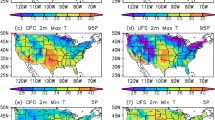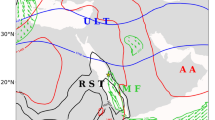Abstract
In this study, a synoptic and mesoscale analysis was performed and Szilagyi’s waterspout forecasting method was tested on ten waterspout events in the period of 2013–2016. Data regarding waterspout occurrences were collected from weather stations, an online survey at the official website of the National Meteorological and Hydrological Service of Croatia and eyewitness reports from newspapers and the internet. Synoptic weather conditions were analyzed using surface pressure fields, 500 hPa level synoptic charts, SYNOP reports and atmospheric soundings. For all observed waterspout events, a synoptic type was determined using the 500 hPa geopotential height chart. The occurrence of lightning activity was determined from the LINET lightning database, and waterspouts were divided into thunderstorm-related and “fair weather” ones. Mesoscale characteristics (with a focus on thermodynamic instability indices) were determined using the high-resolution (500 m grid length) mesoscale numerical weather model and model results were compared with the available observations. Because thermodynamic instability indices are usually insufficient for forecasting waterspout activity, the performance of the Szilagyi Waterspout Index (SWI) was tested using vertical atmospheric profiles provided by the mesoscale numerical model. The SWI successfully forecasted all waterspout events, even the winter events. This indicates that the Szilagyi’s waterspout prognostic method could be used as a valid prognostic tool for the eastern Adriatic.
















Similar content being viewed by others
References
American Meteorological Society, cited 2017: Waterspout. Glossary of Meteorology. Available online at http://glossary.ametsoc.org/wiki/waterspout.
Antonescu, B., Schultz, D. M., Lomas, F., & Kühne, T. (2016). Tornadoes in Europe: synthesis of the observational datasets. Monthly Weather Review, 144, 2445–2480.
Belušić, A., Telišman Prtenjak, M., Güttler, I., Ban, N., Leutwyler, D., & Schär, C. (2017). Near-surface wind variability over the broader Adriatic region: insights from an ensemble of regional climate models. Climate Dynamics. https://doi.org/10.1007/s00382-017-3885-5.
Betz, H. D., Schmidt, K., Laroche, P., Blanchet, P., Oettinger, W. P., Defer, E., et al. (2009). LINET—an international lightning detection network in Europe. Atmospheric Research, 91, 564–573.
Bošković, R. (1749). Sopra il turbine che la notte tra gli XI, e XII Giugno del MDCCXLIX daneggio` una gran parte di Roma dissertazione, Rome.
Caruso, J. M., & Davies, J. M. (2005). Tornadoes in non-mesocyclone environments with pre-existing vertical vorticity along convergence boundaries. NWA Electronic Journal of Operational Meteorology, 6(4), 1–36.
Davies-Jones, R., Trapp, R. J., & Bluestein, H. B. (2001). Tornadoes and tornadic storms. In C. A. Doswell III (Ed.), Severe convective storms (pp. 167–221). Boston MA: American Meteorological Society.
Doswell, C. A., III, & Evans, J. S. (2003). Proximity sounding analysis for derechos and supercells: an assessment of similarities and differences. Atmospheric Research, 67–68, 117–133.
Doswell, C. A., III, & Rasmussen, E. N. (1994). The effect of neglecting the virtual temperature correction on CAPE calculations. Weather and Forecasting, 9, 625–629.
Dotzek, N., Emeis, S., Lefebvre, C., & Gerpott, J. (2010). Waterspouts over the North and Baltic Seas: Observations and climatology, prediction and reporting. Meteorologische Zeitschrift, 19, 115–129.
Ferro, C. A. T. (2007). A Probability model for verifying deterministic forecasts of extreme events. Weather and Forecasting, 22, 1089–1100.
Ferro, C. A. T., & Stephenson, D. B. (2011). Extremal dependence indices: improved verification measures for deterministic forecasts of rare binary events. Weather and Forecasting, 26, 69–713.
Feudale, L., & Manzato, A. (2014). Cloud-to-ground lightning distribution and its relationship with orography and anthropogenic emissions in the Po Valley. Journal of Applied Meteorology and Climatology, 53, 2651–2670.
Giaiotti, D. B., Giovannoni, M., Pucillo, A., & Stel, F. (2007). The climatology of tornadoes and waterspouts in Italy. Atmospheric Research, 83(2), 534–541.
Golden, J. H. (1974). The life cycle of Florida Keys’ waterspouts I. Journal of Applied Meteorology, 13, 676–692.
Groenemeijer, P. H., & van Delden, A. (2007). Sounding-derived parameters associated with large hail and tornadoes in the Netherlands. Atmospheric Research, 83, 473–487.
Holler, H., Betz, H. D., Schmidt, K., Calheiros, R. V., May, P., Houngninou, E., et al. (2009). Lightning characteristics observed by a VLF/LF lightning detection network (LINET) in Brazil, Australia, Africa and Germany. Atmospheric Chemistry and Physics, 9, 7795–7824.
Holley, D. M., Dorling, S. R., Steele, C. J., & Earla, N. (2014). A climatology of convective available potential energy in Great Britain. International Journal of Climatology, 34, 3811–3824.
Horvat, I., Renko, T., Stanešić, A., Szilagyi, W. (2017). Development of operational waterspout forecast product for Adriatic Sea using ALADIN NWP model. In: 9th European Conference on Severe Storms, pp. 18–22. Pula, Croatia.
Horvath, K., Koracin, D., Vellore, R. K., Jiang, J., & Belu, R. (2012). Sub-kilometer dynamical downscaling of near-surface winds in complex terrain using WRF and MM5 mesoscale models. Journal of Geophysical Research, 117, D11111. https://doi.org/10.1029/2012JD017432.
Ivančan-Picek, B., Horvath, K., Strelec Mahović, N., & Gajić-Čapka, M. (2014). Forcing mechanisms of a heavy precipitation event in the southern Adriatic area. Natural Hazards, 72(2), 1231–1252.
Ivančan-Picek, B., Tudor, M., Horvath, K., Stanešić, A., & Ivatek-Šahdan, S. (2016). Overview of the first HyMeX special observation period over Croatia. Natural Hazards and Earth System Sciences, 16, 2657–2682.
Ivatek-Šahdan, S., & Tudor, M. (2004). Use of high-resolution dynamical adaptation in operational suite and research impact studies. Meteorologische Zeitschrift, 13(2), 1–10.
Kehler-Poljak, G., Telišman Prtenjak, M., Kvakić, M., Šariri, K., & Večenaj, Ž. (2017). Interaction of sea breeze and deep convection over the northeastern Adriatic coast: an analysis of sensitivity experiments using a high-resolution mesoscale model. Pure and Applied Geophysics, 174, 4197–4224. https://doi.org/10.1007/s00024-017-1607-x.
Keul, A. G., Sioutas, M. V., & Szilagyi, W. (2009). Prognosis of central-eastern Mediterranean waterspouts. Atmospheric Research, 93, 426–436.
Khodayar, S., Fosser, G., Berthou, S., Davolio, S., Drobinski, P., Ducrocq, V., et al. (2016). A seamless weather–climate multi-model intercomparison on the representation of a high impact weather event in the western Mediterranean: HyMeX IOP12. Quarterly Journal of the Royal Meteorological Society, 142(1), 433–452.
Kuzmić, M., Grisogono, B., Li, X. M., & Lehner, S. (2015). Examining a deep and a shallow Adriatic bora event. Quarterly Journal of the Royal Meteorological Society, 141, 3434–3438.
Markowski, P. M., & Richardson, Y. P. (2009). Tornadogenesis: Our current understanding, forecasting considerations and questions to guide future research. Atmospheric Research, 93, 3–10.
Marsh, P. T., Hart, J. A. (2012). SHARPPY: a Python implementation of the Skew-T/Hodograph Analysis and Research Program. AMS 2nd symposium on advances in modeling and analysis using Python. https://ams.confex.com/ams/92Annual/webprogram/Paper203274.html. Accessed Aug 8, 2017.
Mikuš, P., Telišman Prtenjak, M., & Strelec Mahović, N. (2012). Analysis of the convective activity and its synoptic background over Croatia. Atmospheric Research, 104–105, 139–153.
National Oceanic and Atmospheric Administration (2016). Retrieved May 5, 2017, from http://oceanservice.noaa.gov/facts/waterspout.html.
Office, Meteorological. (1962). Weather in the Mediterranean (Vol. 1). London: General Meteorology, Her Majesty’s Stationery Office.
Poljak, G., Telišman Prtenjak, M., Kvakić, M., Strelec Mahović, N., & Babić, K. (2014). Wind patterns associated with the development of daytime thunderstorms over Istria. Annales Geophysicae, 32, 401–420.
Pucik, T., Groenemeijer Ryva, D., & Kolar, M. (2015). Proximity soundings of severe and nonsevere thunderstorms in central Europe. Monthly Weather Review, 143, 4805–4821.
Rasmussen, E. N., & Blanchard, D. O. (1998). A baseline climatology of sounding-derived supercell and tornado forecast parameters. Weather Forecasting, 13, 1148–1164.
Renko, T., Kozarić, T., & Tudor, M. (2013). An assessment of waterspout occurrence in the Eastern Adriatic basin in 2010: synoptic and mesoscale environment and forecasting method. Atmospheric Research, 123, 71–81.
Renko, T., Kuzmić, J., Šoljan, V., & Strelec Mahović, N. (2016). Waterspouts in the Eastern Adriatic from 2001 to 2013. Natural Hazards, 82, 441–470.
Rodríguez, O., & Bech, J. (2017). Sounding-derived parameters associated with tornadic storms in Catalonia. International Journal of Climatology. https://doi.org/10.1002/joc.5343.
Sherburn, K. D., & Parker, M. D. (2014). Climatology and ingredients of significant severe convection in high shear, low CAPE environments. Weather Forecasting, 29, 854–877.
Sherburn, K. D., Parker, M. D., King, J. R., & Lackman, G. M. (2016). Composite environments of severe and non-severe high-shear, low-CAPE convective events. Weather Forecasting, 31, 1899–1927.
Sioutas, M. V., & Flocas, H. A. (2003). Hailstorms in northern Greece: synoptic patterns and thermodynamic environment. Theoretical and Applied Climatology, 75, 189–202.
Sioutas, M. V., & Keul, A. G. (2007). Waterspouts of the Adriatic, Ionian and Aegean Sea and their meteorological environment. Atmospheric Research, 83, 542–557.
Sioutas, M., Szilagyi, W., & Keul, A. (2013). Waterspout outbreaks over areas of Europe and North America: environment and predictability. Atmospheric Research, 123, 167–179.
Skamarock, W. C., Klemp, J. B., Dudhia, J., Gill, D. O., Barker, D. M., Duda, M. G., et al. (2008). A description of the advanced research WRF version 3, NCAR/TN-475+STR. Boulder: NCAR.
Supić, N., & Orlić, M. (1992). Annual cycle of sea surface temperature along the east Adriatic coast. Geofizika, 9, 79–97.
Szilagyi, W. (2009). A waterspout forecasting technique. https://www.essl.org/ECSS/2009/preprints/O05-14-sziladgyi.pdf. Accessed 5 May 2017.
Taszarek, M., Brooks, H. E., & Czerneck, B. (2017). Sounding-derived parameters associated with convective hazards in Europe. Monthly Weather Review, 145, 1511–1528.
Telišman Prtenjak, M., & Grisogono, B. (2007). Sea/land breeze climatological characteristics along the northern Croatian Adriatic Coast. Theoretical and Applied Climatology, 90(3–4), 201–215.
Telišman Prtenjak, M., Viher, M., & Jurković, J. (2010). Sea/land breeze development during a summer bora event along the north-eastern Adriatic coast. Quarterly Journal of the Royal Meteorological Society, 136, 1554–1571.
Telišman Prtenjak, M. Horvat, I., Tomažić, I., Kvakić, M., Viher, M., & Grisogono, B. (2015) Impact of mesoscale meteorological processes on anomalous radar propagation conditions over the northern Adriatic area, Journal of Geophysical Research – Atmospheres, 120, 17, 8759-8782.
Thompson, R. L., Edwards, R., Hart, J. A., Elmore, K. L., & Markowski, P. (2003). Close proximity soundings within supercell environments obtained from the rapid update cycle. Weather Forecasting, 18, 1243–1261.
van Delden, A. (2001). The synoptic setting of thunderstorms in western Europe. Atmospheric Research, 56, 89–110.
Acknowledgements
The authors wish to thank Dr. Szilagyi, who shared his knowledge of the SWN and SWI. We would also like to thank all of the individuals who helped us to collect the data. This research was supported by the ECMWF (http://www.ecmwf.int/) data, atmospheric soundings from http://weather.uwyo.edu/upperair/sounding.html and the WRF-ARW model freely available at www.wrf-model.org/index.php. The contribution of Sarah Ivušić to this paper was partially funded by HrZZ contract I-3833-2016. Sarah Ivušić also thanks Kristian Horvath and Ivan Güttler for their available discussion and comments. Maja Telišman Prtenjak wishes to acknowledge the Croatian Science Foundation project VITCLIC (PKP-2016-06-2975), which is funded by the Environmental Protection and Energy Efficiency Fund under the Government Programme (Ministry of Environment and Energy & Ministry of Science and Education) for the Promotion of Research and Development Activities in the Field of Climate Change for the period 2015–2016.
Author information
Authors and Affiliations
Corresponding author
Rights and permissions
About this article
Cite this article
Renko, T., Ivušić, S., Telišman Prtenjak, M. et al. Waterspout Forecasting Method Over the Eastern Adriatic Using a High-Resolution Numerical Weather Model. Pure Appl. Geophys. 175, 3759–3778 (2018). https://doi.org/10.1007/s00024-018-1833-x
Received:
Revised:
Accepted:
Published:
Issue Date:
DOI: https://doi.org/10.1007/s00024-018-1833-x




